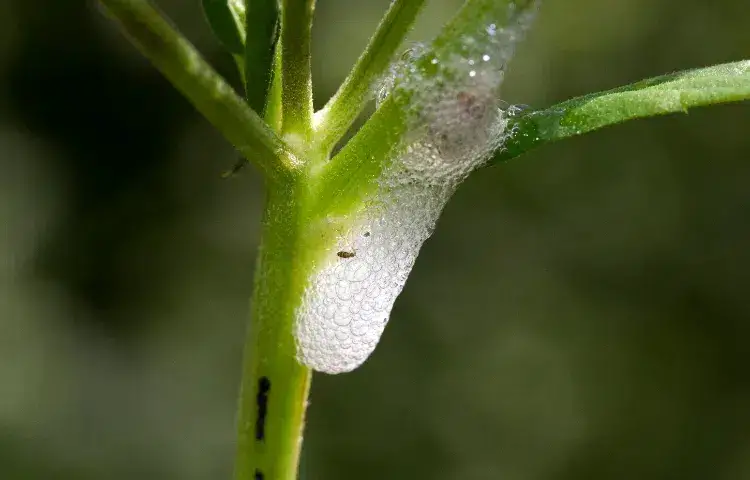What is Cuckoo Spit?

Cuckoo spit is a frothy, white foam-like substance found on plants, created by leafhoppers to protect their eggs. These insects, which resemble small grasshoppers, use the foam to shield their eggs from drying out and predators. The larvae inside this foam start feeding on the plant’s leaves and stems once they hatch.
Leafhopper ID Card
The leafhopper is a small insect, less than 1 cm in size, and can be brown, beige, or green. It’s known for its ability to jump and fly. The insect’s appearance is similar to a tiny, white or greenish butterfly with closed, waxy wings forming a dome. Leafhoppers are active from spring to late summer, from May to September, and lay their eggs on leaves, buds, or under bark.
Key Leafhopper Species:
- Rose Leafhopper (Typhlocyba rosae)
- Potato Leafhopper (Empoasca fabae)
- Aster Leafhopper (Macrosteles fascifrons)
- Golden Flavescence Leafhopper (Scaphoideus titanus)
- Fence Leafhopper (Empoasca vitis)
- Pruinose Leafhopper (Metcalfa pruinosa)
- Foaming Leafhopper (Philaenus spumarius): This is the species responsible for the cuckoo spit.
What Problems Can Leafhoppers Cause?
Leafhoppers can cause a variety of issues for plants, including:
- Yellowing Leaves: Small yellow dots or spots on leaves from the insect’s feeding.
- Moss Development: Moss growth on stems and leaves.
- Plant Health Problems: The affected plants may dry out, become faded, or cease to develop properly.
- Disease Transmission: Leafhoppers can spread diseases such as sooty mold and other cryptogamic diseases.
If left unchecked, leafhoppers can severely impact plant health, potentially leading to plant death.
How to Remove Cuckoo Spit
1. Use a Powerful Jet of Water:
Spray a strong stream of water on the affected plants. This method will wash away the cuckoo spit and eliminate the protective layer around the larvae, leading to their death.
2. Natural Predators:
Encourage natural predators like insectivorous birds, ladybugs, and predatory bedbugs, which help control leafhopper populations.
3. Black Soap Solution:
Apply a black soap solution, similar to the one used for aphids, two to three times a week. This will help to manage leafhopper infestations effectively.
4. Avoid Certain Natural Predators:
While Neodryinus typhlocybae is effective against leafhoppers, it can also cause harm to other beneficial insects in the garden. Use with caution.



